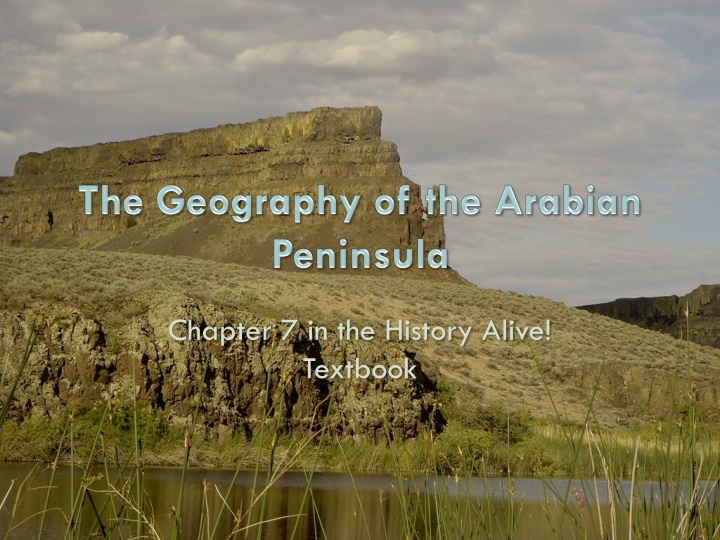
Exploring Arabia: Land of Trade, Deserts, and Oases
In Chapter 7 of the History Alive! textbook, we delve into the geographical features of Arabia, the birthplace of Islam and a crucial crossroads of trade between Asia, Africa, and Europe. The arid Arabian Peninsula posed environmental challenges but also hosted vital oases and trade routes controlled by Bedouins. Discover the significance of deserts, coastal plains, mountain ranges, and the cultural adaptations developed by the people living in this challenging landscape.
Download Presentation

Please find below an Image/Link to download the presentation.
The content on the website is provided AS IS for your information and personal use only. It may not be sold, licensed, or shared on other websites without obtaining consent from the author. If you encounter any issues during the download, it is possible that the publisher has removed the file from their server.
You are allowed to download the files provided on this website for personal or commercial use, subject to the condition that they are used lawfully. All files are the property of their respective owners.
The content on the website is provided AS IS for your information and personal use only. It may not be sold, licensed, or shared on other websites without obtaining consent from the author.
E N D
Presentation Transcript
Chapter 7 in the History Alive! Textbook
Muhammad, the founder of Islam was born on the peninsula in about 570 C.E. Arabian peninsula is in the southwest Asia, between the Red Sea and the Persian Gulf* Most of the people living in Arabia in the 6thcentury were Arabs** From the air, you see vast deserts dotted by oases. Coastal plains line the southern and western coasts. Mountain ranges divide these coastal plains from the deserts. The hot, dry Arabian Peninsula is a challenging place to live.
Arabia lies at the crossroads of Asia, Africa, and Europe* A great deal of trade passed through this region** As early as 2000 BCE, the people of Arabia served as middlemen in the trade between these lands*** Knowledge, ideas, technology, and goods flowed through Arab lands****
About of the Arabian Peninsula is covered by desert which includes vast seas of sand, plains, and plateaus (a raised area of flat land) Environment* Adaptations Shelter** Transportation*** Clothing/Nutrition**** Some Bedouins controlled the valuable trade routes that linked towns and villages. Merchants operated caravans that carried goods across the desert*****
The desert is dotted with oases, areas where fresh water is available Oases are important because they provide plant life and shade as well as water Environment* Adaptations** A number of towns developed around oases, linked by tracks through the desert***
It runs along the coasts of the peninsula and separates inland plateaus from the Red Sea, the Arabian Sea, and the Persian Gulf. Environment* Adaptations**
Arabias largest mountain ranges run along the western and southern edges of the peninsula. They divide the coastal plain from the desert. Environment* Adaptations**
